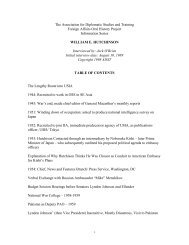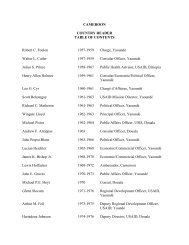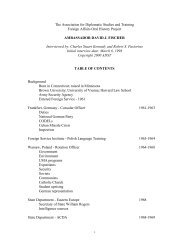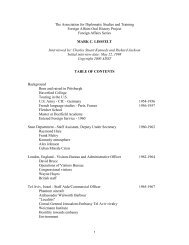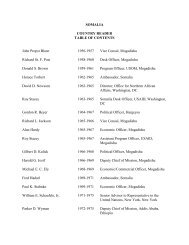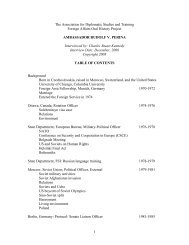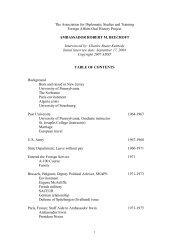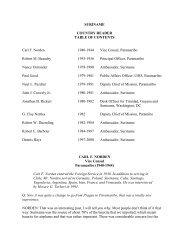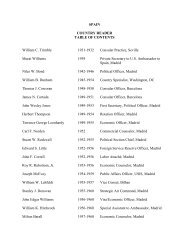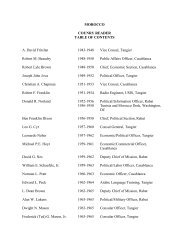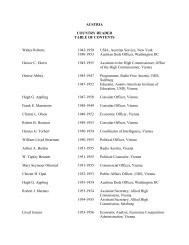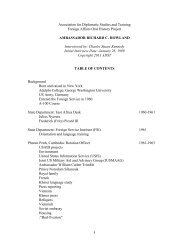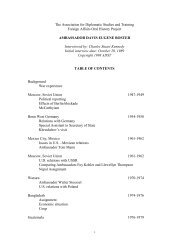1 The Association for Diplomatic Studies and Training Foreign ...
1 The Association for Diplomatic Studies and Training Foreign ...
1 The Association for Diplomatic Studies and Training Foreign ...
You also want an ePaper? Increase the reach of your titles
YUMPU automatically turns print PDFs into web optimized ePapers that Google loves.
said, “We taught American studies at Moscow University as well as being in the<br />
Institute,” Arbatov’s expertise became extremely valuable, even more valuable than it had<br />
been originally. <strong>The</strong> USA-Canada Institute still exists, but it has suffered the decline that<br />
all the Soviet institutions have, including the Academy of Sciences itself. <strong>The</strong>y have to<br />
find new sources of funding <strong>and</strong> their place in society is much different even though it is<br />
still a privileged group. <strong>The</strong>y’re one of among many others. New universities, <strong>and</strong> the<br />
re<strong>for</strong>med old universities are trans<strong>for</strong>ming the education system. For example, the<br />
privileged place of institutes as opposed to university faculties is a great issue of<br />
contention now. I’m sure it will result in further diminishing of the institutes from first<br />
place toward the direction of university education.<br />
Q: Did the CIA, KGB recruiters <strong>and</strong> all that sort of get mixed up in this whole thing?<br />
MILLER: No, because KGB was disintegrating so fast, changing itself, into institutions<br />
under more direct public civilian control. CIA was very interested. Of course, our<br />
American board members would tell them whatever they wanted to know. Beyond the<br />
analytic side, CIA’s covert work, was not relevant at this point.<br />
Q: Things were moving too fast?<br />
MILLER: Moving much too fast.<br />
Q: You could almost pick the wrong guy.<br />
MILLER: No, I’d say our CIA analysts were terrific/ Those who had the most work to do,<br />
the bean-counters, the nuclear types, were in heaven at this stage, because of everything<br />
they used to see from 200 miles above, they could now see firsth<strong>and</strong> <strong>and</strong> even touch.<br />
Q: What was happening on the nuclear side during this period?<br />
MILLER: <strong>The</strong> fundamental necessary decisions had been made by Gorbachev <strong>and</strong> by the<br />
Soviets, that there would be a strategic weapons halt; there would be an agreed nuclear<br />
plateau of technology. Gorbachev was convinced that there was not going to be a nuclear<br />
war between the United States <strong>and</strong> the Soviet Union, that these nuclear weapons should<br />
be reduced to the lowest possible levels. Gorbachev himself proposed zero. <strong>The</strong> argument<br />
became not how large a <strong>for</strong>ce you could have, but how small a <strong>for</strong>ce you could have.<br />
<strong>The</strong>re were many proposals abut minimum nuclear <strong>for</strong>ce levels. For example, I wrote a<br />
proposal in 1987 which showed how 2,000 warheads was the number that would give you<br />
at least double insurance, even triple insurance, to be able to hit all targets believed<br />
strategic. That is where we are, now. It was a matter of planning. <strong>The</strong> Russian military are<br />
now at that level, too. <strong>The</strong>y’re retargeting, of course, to other places – China.<br />
Q: How about as students <strong>and</strong> professors <strong>and</strong> all, was there an explosion in Soviet<br />
students going out – I’m thinking of American, but of others coming in?<br />
140




